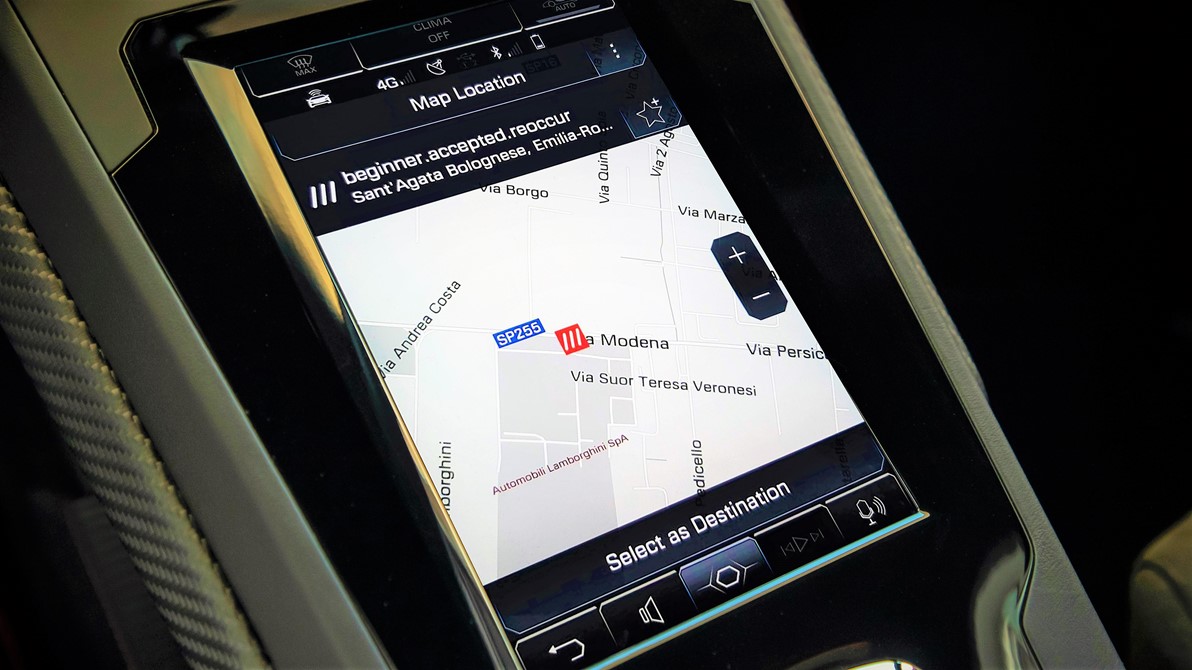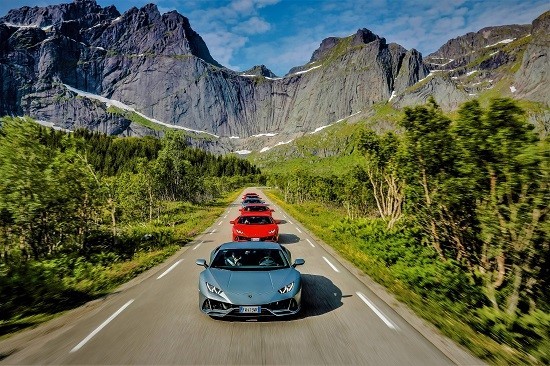In most
modern cars and
SUVs, dashboard navigation systems help motorists plot a road
trip, give them a route to client meetings, or lead them to their children’s
away soccer games. But where is a
Lamborghini Huracán driver headed?
اضافة اعلان
Wherever that may
be, a new navigation system starting in 2022 models will help get the car there
— and hopefully with greater certainty. A console-mounted app called What3words
is coming to these Lamborghinis, and it will be the first of its kind to
incorporate Amazon’s voice-activated Alexa feature.
Previously
available in other cars, but without Alexa, the
What3words system divides the
world into 57 trillion 10-foot (3-by-3-meter) squares and assigns each a unique
three-word address code randomly chosen from a customized standard dictionary.
“The Huracán app
is significant,” said
Chris Sheldrick, CEO of What3words, which is based in
London. “So many drivers struggle with inputting the address and wind up at the
wrong location.”
Aimed at enhancing
both the speed and accuracy of car navigation systems, What3words is said to
overcome common issues such as duplicate street names. To cite a few: There are
367 Park Streets in California; Australia has 521 George Streets; and in
Greater London, there are 14 Church Roads.
“Traditional
addresses often are not suitable for voice input,” Sheldrick added, “and a lot
of the time, the best spots don’t have any addresses at all.”
For example, a Huracán driver wishing to view San
Francisco Bay from the south end of the
Golden Gate Bridge would first call up
an image of the bridge on the What3words screen, then identify the coded,
10-foot square corresponding to that location. After voicing the code aloud —
in this case “scar-milk-focus” — the driver would follow Alexa’s guidance to
that exact spot.
 Lamborghini’s voice-activated navigation system using Alexa and What3words, an app that has broken down the globe into 10-foot squares and assigned each block a three-word address. (Photo: NYTimes)
Lamborghini’s voice-activated navigation system using Alexa and What3words, an app that has broken down the globe into 10-foot squares and assigned each block a three-word address. (Photo: NYTimes)
The navigation
system is part of Lamborghini’s push to meet customer expectations beyond
horsepower. This year reportedly will be the company’s last to offer internal
combustion engines only; in 2023 it is expected to debut hybrid models, with
all-electrics coming later in the decade. (All of this technology and prowess
may be paying off for Lamborghini, which in 2021 posted its best year ever,
delivering 8,405 cars.)
“We start with the
car and its driver,” said
Luca Giardino, head of connectivity for Lamborghini.
“The Huracán links computer software and hardware in ways that enhance that
relationship. What3words allows greater focus on the pure driving experience —
without the distraction of being uncertain whether or not you will arrive at
the correct destination.”
Sheldrick, a
former music promoter and organizer, developed What3words in response to
frequent address difficulties faced by his touring musicians. For example, he
recalled an incident in Italy when a driver unloaded a truckload of instruments
an hour north, rather than an hour south, of Rome. On another occasion, a frantic
keyboard player called him from somewhere in London and said, “Don’t panic,
Chris, but we may have just sound-checked the wrong wedding.”
Sheldrick
contacted a school friend who is a mathematician in hopes of developing a
system that would be as precise as GPS latitude and longitude coordinates but
easier and faster to use. Shortly after their talk, the friend created the
application’s first three-word address algorithm on the back of an envelope.
“Lamborghini is a
trailblazer in being the first to implement this system,” said John
Scumniotales, Alexa Automotive’s head of product. “They certainly won’t be the
last. We’re excited to see how this partnership progresses.”
Huracán drivers do
not pay to use the system; What3words charges a flat fee to Lamborghini and
other companies that buy the app.
“People around the
world are using What3words addresses to find, share and describe places faster
and more easily,” Sheldrick said, “from festivalgoers to delivery drivers,
event organizers and postal services.”
Voiceless versions
of the What3words technology have been adopted in selected models by other
carmakers, including
Mercedes-Benz, Lotus, Tata Motors, and Ford. The app is
free to download on Apple iPhones and iPads and on Android platforms, which can
then integrate with Apple CarPlay and Android Auto.
“This could be
really convenient when I’m trying to figure out which parking lot to use when I
go to my son’s football games,” said Chris Gerdes, a professor of mechanical
engineering at Stanford and co-director of the university’s Center for
Automotive Research.
 Lamborghini’s Huracán EVO Spyder. The $200,000 V-10 Huracán can sprint from zero to 60 miles an hour in 2.5 seconds. (Photo: NYTimes)
Lamborghini’s Huracán EVO Spyder. The $200,000 V-10 Huracán can sprint from zero to 60 miles an hour in 2.5 seconds. (Photo: NYTimes)
While advanced
navigation tools like What3words hold promise, Gerdes said he remained
skeptical that they would propel automakers on a speedy path to fully
autonomous cars. Creating and orchestrating the intricate mosaic of automated
cameras and sensors, machine-learning tools and algorithms needed to achieve
reliable self-driving cars are far greater technical challenges, he said.
“A successful
autonomous system requires that the self-driving vehicle be constantly aware of
other objects and conveyances” — and how they are moving, Gerdes said.
While widespread
self-driving ability may still be in the future, complex computer applications
and electronics are finding increasing use in high-end “driver’s cars.”
The $200,000 V-10
Huracán, for example, with 602 horsepower and a 0-to-60 acceleration time of
2.5 seconds, fairly bristles with computer-assisted performance. Its
“predictive system” adjusts for driver inputs in a way that can even correct
for gear-shifting errors.
Indeed, in
conversation with company executives, the CEO, Stephan Winkelmann, has
indicated that Lamborghini is open to autonomous operation as a future option
in “dense urban traffic situations where driving isn’t fun.”
And Gerdes said
Lamborghini representatives had recently visited Stanford to view a
demonstration of the center’s autonomous race cars.
The growing
embrace of technology is notable. Former
Ferrari chief Sergio Marchionne once
famously described the idea of an electric vehicle’s wearing the prancing horse
badge as an “almost obscene concept.” But in 2013 came the 963-horsepower La
Ferrari, the company’s first car to use a hybrid drive system featuring a V-12
internal combustion engine and two electric motors.
Last year, Ferrari
added a third electric motor to its SF90 Stradale for a boost to 983
horsepower. The Purosangue, the automaker’s much-anticipated, first-ever SUV,
is widely expected to offer a plug-in hybrid when introduced this year.
“If you look at
where modern cars are going, I definitely think autonomous operation will
become part of the future enthusiast car experience,” Gerdes said. “It will be
very possible to build cars that enthusiasts love to drive when they want to
and then can switch to autonomous operation when they don’t.”
The Patrick Ottis
Company in Berkeley, California, is widely ranked among the world’s premier
restorers of vintage Ferrari automobiles and motors. Ottis said that in May he
will “mark a half-century of repairing Ferrari internal combustion engines.”
His shop is
keeping pace with Ferrari’s updates. “We’ve just taken on a talented Ferrari
mechanic with 40 years’ experience,” Ottis said. “He’s totally conversant with
all the new models, including La Ferrari.
“Since he’s been here,
I’ve driven a couple of the newer Ferraris, and when I get in a three- or
four-year-old Ferrari, it’s so great I can’t even appreciate it. That’s when I
realize how amazing the future is. And that it’s just going to continue.”
Read more Drive



